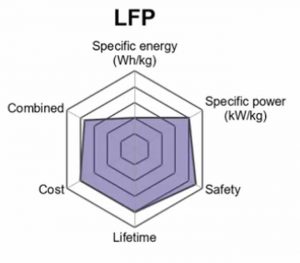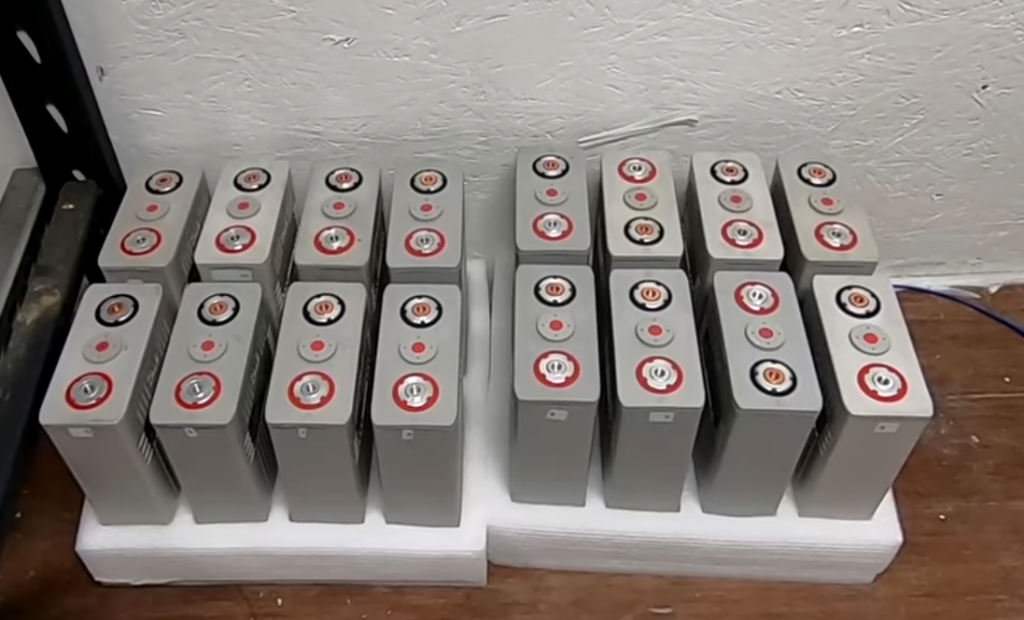Lithium-ion batteries are a type of rechargeable battery in which lithium ions move from the negative electrode to the positive electrode during discharge and back when charging. As such, they belong to a class of electrochemical cells known as “metal oxide” batteries that use metal oxides as one of their electrodes.
Lithium-ion batteries can be further classified into two types: single-layer cells (also called thin-film) and multi-layer cells (or thick film). For this article, though, we’ll focus on single-layer cells since these are typically used for portable electronics applications like laptops or cell phones and more recently in Electric Vehicles and Battery Banks.
What type of lithium battery is used for solar ?
When it comes to solar applications, there are 4 types of lithium-ion batteries that are used for this purpose. The first is the lithium iron phosphate (LFP) cell, usually abbreviated as LiFePO4 or LFP.
An LFP battery uses a solid electrolyte made from lithium iron phosphate ceramic which makes it more stable than liquid electrolyte cells. This type is very stable and offers a long cycle life of more than 1,000 full charge/discharge cycles before losing around 5% of its capacity.
In addition, the cell has low internal resistance that’s why it’s good for solar applications. We actually recommend this type of battery for solar and deep cycle applications.
Another type is the lithium titanate (LTO) cell, usually abbreviated as Li4Ti5O12 or LTO. This type of lithium battery has better specific energy (energy density) than the LiFePO4 cell which means it is capable of holding more power.
This makes it ideal for high-drain devices like electric tools and bicycles. The only downside of the cell is that it has a lower cycle life which means it can only withstand around 1,000 cycles or less.
The other two types are lithium nickel manganese cobalt (NMC) and lithium nickel cobalt aluminum oxide (NCA). These cells are very similar to the LFP and LTO cells but they use different materials for the negative electrode (cathode). The downside of these types is that they can swell after many cycles which can crack their housing. They are mainly used in Electric Vehicles.

So if you are looking for a good solar battery the LFP or LiFePO4 battery would be best. We list some of the best deep cycle LiFePO4 batteries in this article. They are lightweight, high capacity and they offer long cycle lives which make them perfect for solar applications.
Advantages of the LiFePO4 Battery
The LFP battery has come to replace Lead Acid batteries in backups, telecommunication, and off-grid solutions. This is because of the many advantages it has over the Lead-acid batteries and this includes the newer types of Sealed Lead Acid batteries like AGM batteries. But there are some arguments for sticking with AGM.
Lighter weight.
The Lithium battery is the most lightweight. It weighs half to one-third less than the lead battery weight (for an identical run time/capacity.

Greater electrical efficiency
Lithium batteries have a higher electrical efficiency than lead-acid batteries. LiFePO4 batteries have a 98% charge efficiency. This means that a Lithium battery will not only charge more efficiently but also more quickly than a standard lead-acid battery.
This is especially important for situations where there are not many charging options, such as solar panels where you have a limited time when sunlight is available.
Longer working life.
With LiFePo4 batteries, you get a longer working life. This is because a Lithium battery can last up to 5000 cycles compared to 500 cycles from a lead-acid battery. A cycle refers to the number of times the battery can be charged and discharged. A 5000 cycle battery can last anywhere between 3 to 10 years depending on how many times it is charged and discharged.
Constant Voltage.
A lithium battery maintains a constant voltage even when it is being discharged. A fully charged 12v lithium battery will have a reading of around 14v constantly when using it and it is only when it is about to die that the voltage will drop. This compared to Lead acid battery where the voltage continuously drops as the battery is discharged. This can lead to disruptions when you are running appliances off the battery.
Recharge faster
You will spend less time charging Lithium batteries than you would with lead-acid batteries as lithium batteries have low internal resistance.
Safer
LiFePO4 batteries are safer than lead-acid batteries are they are free from corrosive sulfuric acid and toxic metals like lead and cadmium. They also do not need ventilation as they do not produce gases and do not produce heat when charging.
Factors to consider when choosing a lithium battery for solar?
When choosing a lithium battery, or any battery for that matter there are some basic things you will need to look at in order for the battery to be adequate for your system. We look at a few of them:
Capacity or Specific Energy
Specific energy or capacity is the amount of electrical energy it can deliver per unit mass). The higher the specific energy of the battery, the better for solar applications.
Voltage
Another factor to consider is its voltage since not all photovoltaic panels have a similar output voltage level. For instance, some may have a lower voltage so you need to match it with appropriate cell chemistry which offers higher output voltage levels.
Charge and Discharge Rate
One final factor is charge and discharge rates since the battery’s capability to accept current will depend on it. It should be compatible with the power output of your solar panel or else it won’t be able to fully charge the cells.
How long can lithium batteries be stored safely
Lithium batteries can be stored for long periods of time without them dying. This is because they have a low discharge rate. This is the reason why they are a good option for backups. Lithium batteries are stored at 40% charge and can be stored for months in this state.
How long do Lithium batteries last
Lithium batteries can last anywhere from 1,500 to 10,000 recharges or cycles before it starts deteriorating. This means that if your battery starts losing its capacity past the standard 80% mark, you can still use it without replacing it with a new one. Just recharge it until it reaches 80% capacity before using it again.
How long do they take to charge?
It takes around 1-2 hours to fully charge a lithium battery from 0%. This can take longer for larger batteries especially if they have a lower charging rate.
How much do lithium batteries cost
Lithium batteries are more expensive than other types of rechargeable batteries for solar systems. You can buy a 200ah battery for around $660 to $1,000. However, the cost may vary depending on its manufacturer and specs so it’s best if you compare prices first before committing to one.
You are here
Leave a Reply